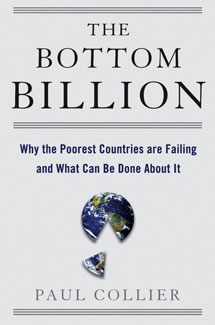The Bottom Billion: Why the Poorest Countries are Failing and What Can Be Done About It, by Paul Collier. Oxford University Press, 2007.
A review by Paul Hoebink.

Paul Collier, with his position between the negativism of William Easterly and the overwhelming optimism of Jeffrey Sachs, has become a Saint in what he himself calls the aid biz and buzz. I left the church when I was 15, and since then have become highly suspicious not so much of the Saints – they often lived decent lives theologizing or supporting the poor and oppressed – but of the believers. If you criticize the Saints, you will be frowned on from heaven, but the believers will call you names, will try to exclude you from debates and will spit at you. My long-time solution for this has been to buy an umbrella. I have always thought that it is important to criticize the Saints. What should our ministers and ministries do with the writings of the Saints, and what should they get out of this book?
The central argument of the book is appealing: the bottom billion poor world citizens are caught in countries that suffer from at least four important traps: they are in a state of civil war; they have abundant natural resources that lead to greed; they live in landlocked countries with bad neighbours; and they are badly governed. It is difficult to escape from these traps. The bottom billion have been abandoned by the international community, but this should stop now, because the problems of the bottom billion will spill over to other countries – to us. An assessment of The Bottom Billion, then, boils down to two questions: Are the four traps real? In what way do the author’s policy prescriptions follow from the analysis of the four traps?
While I have every sympathy with Collier’s appeal to the world community, this book irritates me. In particular I would criticize the cross-country regression analyses that readers can find in the background articles and papers prepared for the book. I don’t consider this type of research to be of great value. The authors of many of those articles have big problems with causality and attribution, and they generally jump to conclusions in an irresponsible way.
What is more important is the problem analysis. I don’t believe that Collier’s four traps (particularly the resource trap) are real traps. I also think that in the bottom billion countries there are some much more important traps, like the ‘not-a-nation trap’, the ‘low-social- development trap’ and the ‘poor endowment trap’. And if we find so many traps, perhaps we are no longer looking at traps, but at a morass.
What is really missing in Collier’s book is a thorough analysis of the donor world. Collier seems to have missed all the important changes here in the last years. His analysis comes no further than the ‘old’ types of aid. He seems to have missed, for example, the sector-wide approaches (SWAps), general budget support and the Paris Declaration on Aid Effectiveness. Thus all his recommendations ‘hang in the air’.
My recommendation to our ministers on this book would be: be critical, take from the book what you think is good, but be suspicious about the ‘science’ behind it, and thus also about some of its prescriptions.
For a longer version of this review download PDF.
